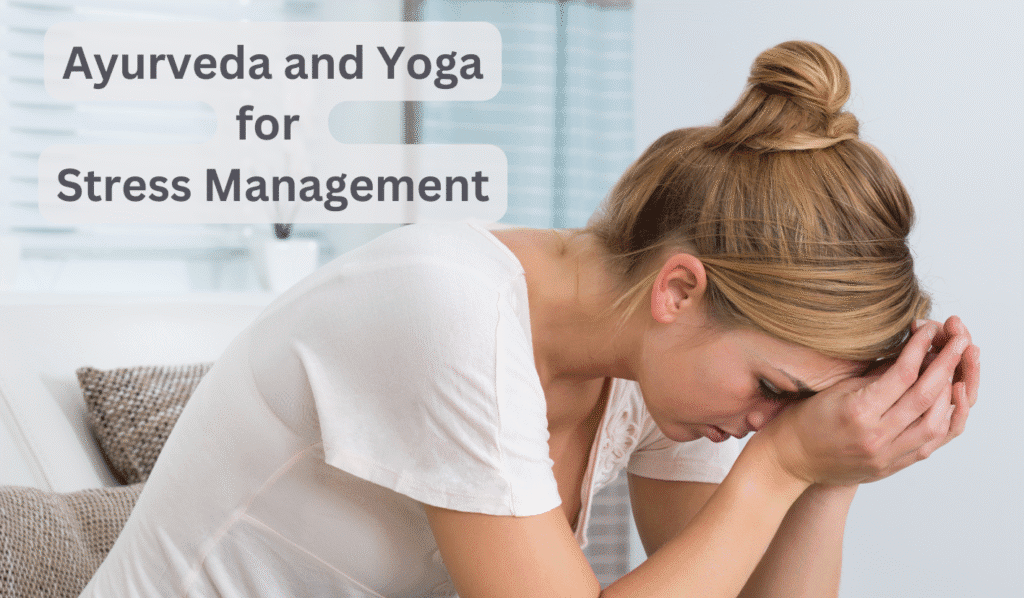Stress as the Modern Epidemic
Stress has quietly become one of the most common health challenges of our times. It does not always appear in dramatic forms; often, it is the subtle, constant pressure of deadlines, digital notifications, financial concerns, and family responsibilities. Over time, this “silent companion” of modern life begins to erode physical health, disturb emotional balance, and cloud mental clarity.
Medical science recognizes stress as a trigger for hypertension, diabetes, digestive disorders, immune dysfunction, and insomnia. Yet, few systems address the root causes as effectively as Ayurveda and Yoga. These twin sciences from India view stress not as an external enemy but as a result of inner imbalance — and provide tools to restore resilience, calmness, and harmony.
Ayurveda’s Perspective on Stress
Understanding Stress Through the Doshas
In Ayurveda, every individual is governed by three fundamental energies or doshas — Vata (air/space), Pitta (fire/water), and Kapha (earth/water). Stress manifests differently depending on which dosha is disturbed:
- Vata imbalance (excess movement/air) → anxiety, overthinking, palpitations, restlessness, insomnia.
- Pitta imbalance (excess fire) → anger, irritability, perfectionism, competitiveness, hypertension.
- Kapha imbalance (excess earth/water) → lethargy, sadness, emotional heaviness, withdrawal.
This framework allows Ayurveda to personalize stress management — instead of a “one-size-fits-all” solution, the approach adapts to the person’s constitution and imbalance.
The Subtle Forces: Prana, Tejas, and Ojas
Ayurveda also describes three subtle essences vital for mental health:
- Prana – governs life force, mental clarity, and perception. Stress depletes Prana, causing fatigue and poor concentration.
- Tejas – the inner radiance of intellect and metabolism. Excess stress overheats Tejas, leading to irritability and burnout.
- Ojas – the vital essence of immunity and stability. When stress diminishes Ojas, resilience and joy decline.
Thus, managing stress in Ayurveda is not merely about calming the mind; it is about rebuilding Prana, balancing Tejas, and nourishing Ojas.
Ayurvedic Tools for Stress Relief
- Herbs (Medhya Rasayanas – brain tonics):
- Ashwagandha (Withania somnifera) – powerful adaptogen that reduces cortisol and strengthens Ojas.
- Brahmi (Bacopa monnieri) – enhances memory, concentration, and calms restlessness.
- Jatamansi (Nardostachys jatamansi) – deeply soothing, reduces insomnia and anxiety.
- Shankhpushpi – improves cognitive stability, balances emotions.
- Panchakarma Therapies:
- Shirodhara (gentle oil stream on forehead) – profoundly calming, reduces anxiety and sleep issues.
- Abhyanga (oil massage) – pacifies Vata, grounds the nervous system.
- Nasya (herbal nasal drops) – clears mental congestion, improves clarity.
- Takradhara (medicated buttermilk stream) – effective for Pitta-related stress and headaches.
- Daily Dinacharya (routine):
- Wake up at sunrise for balanced circadian rhythm.
- Morning Abhyanga with sesame or medicated oil.
- Light, sattvic meals at regular intervals.
- Early bedtime, free from screens and stimulants.
- Dietary Adjustments:
- Favor warm, freshly cooked, lightly spiced food.
- Avoid processed foods, excess caffeine, alcohol, and heavy dinners.
- Incorporate ghee, milk with nutmeg/turmeric, seasonal fruits, and herbal teas (tulsi, chamomile, brahmi).
Yoga’s Role in Stress Management
Yoga as a Nervous System Reset
While Ayurveda prescribes lifestyle and therapies, Yoga provides direct tools for regulating breath, movement, and awareness. Modern science shows that Yoga activates the parasympathetic nervous system, reducing cortisol, lowering heart rate, and promoting relaxation.
Asanas for Stress Relief (with Benefits)
- Balasana (Child’s Pose): Restorative posture that releases tension in spine and hips, calms the mind.
- Setu Bandhasana (Bridge Pose): Opens chest, improves blood flow, alleviates anxiety.
- Paschimottanasana (Seated Forward Bend): Relieves fatigue, stretches the nervous system, aids introspection.
- Viparita Karani (Legs up the Wall): A gentle inversion that reduces fatigue, headaches, and induces calm.
- Savasana (Corpse Pose): Deeply restorative, integrates body-mind relaxation.
Pranayama: The Breath as Medicine
Breathwork directly influences stress levels:
- Nadi Shodhana (Alternate Nostril Breathing): Balances hemispheres of the brain, harmonizes Prana.
- Bhramari (Bee Breath): Vibrational exhalation calms nervous system and reduces agitation.
- Ujjayi (Victorious Breath): Regulates energy, anchors attention, soothes the mind.
- Deep Diaphragmatic Breathing: Expands lungs, improves oxygenation, lowers stress hormones.
Meditation and Mindfulness
- Yoga Nidra (Yogic Sleep): Guided relaxation technique, scientifically proven to reduce insomnia and anxiety.
- Mantra Meditation (e.g., OM chanting): Calms the mind, enhances focus, stabilizes emotions.
- Mindful Observation: Training the mind to stay present reduces worry and rumination.
The Ayurveda–Yoga Synergy
Individually, Ayurveda and Yoga are powerful. Together, they form a complete stress management system:
- Ayurveda identifies dosha imbalance and prescribes diet, herbs, and therapies.
- Yoga provides asana, pranayama, and meditation to restore balance.
- The integration ensures that not only symptoms reduce but also resilience is built against future stress.
Example of Personalized Integration:
- Vata Predominant Stress: Warm oil massage, grounding food, restorative yoga, slow pranayama.
- Pitta Predominant Stress: Cooling herbs, meditation, forward-bending postures, sheetali pranayama.
- Kapha Predominant Stress: Stimulating diet, invigorating yoga flow, dynamic pranayama like kapalabhati.
Practical Stress-Relief Routine (Sample One-Day Plan)
- Morning: Wake with sunrise, practice Abhyanga with sesame oil, sip warm ginger tea.
- Yoga Session: 20 minutes of gentle asanas + 10 minutes pranayama (Nadi Shodhana, Bhramari).
- Midday: Light sattvic lunch with whole grains, vegetables, and ghee.
- Afternoon: Herbal tea (tulsi, brahmi). Short mindful breathing practice.
- Evening: Shirodhara or meditation session, journaling for reflection.
- Night: Warm turmeric milk, screen-free wind-down, early bedtime.
This simple plan balances all three doshas, builds Ojas, and trains the nervous system to shift from stress to calm.
Modern Science Meets Ancient Wisdom
Research increasingly validates Ayurveda and Yoga for stress:
- Ashwagandha reduces cortisol by up to 30% (Indian Journal of Psychological Medicine, 2012).
- Yoga practice lowers blood pressure and improves heart rate variability, markers of stress resilience.
- Meditation and Yoga Nidra enhance gray matter density in the brain areas linked to emotional regulation.
- Shirodhara therapy has been clinically shown to reduce anxiety and improve sleep quality.
This convergence of modern science with traditional wisdom makes Ayurveda and Yoga highly relevant for today’s stress epidemic.
Conclusion: A Path to Inner Calm
Stress may be unavoidable, but suffering from it is optional. Through Ayurveda’s holistic therapies and Yoga’s mind-body practices, one can learn not only to manage stress but also to transform it into an opportunity for self-growth. The combined approach addresses body, mind, and spirit, creating a foundation of resilience, clarity, and peace.
At Shantitheeram Ayurveda, our Stress Relief & Sleep Restoration Programs weave together authentic Ayurvedic treatments, calming Yoga, and guided meditation — personalized to your unique constitution. The result is not just relief from stress but a sustainable pathway to inner harmony and renewed vitality.
Frequently Asked Questions on Ayurveda & Yoga for Stress
1. Can Ayurveda really cure stress completely? Ayurveda does not look at stress as a “disease” to be cured but as an imbalance of body and mind. With herbs, therapies, and lifestyle changes, it helps restore balance, reduce symptoms, and build long-term resilience.
2. Which Ayurvedic herbs are best for managing stress? Popular herbs include Ashwagandha (adaptogen that lowers cortisol), Brahmi (improves clarity), Jatamansi (calming for the mind), and Shankhpushpi (supports emotional stability). The right choice depends on your dosha and should be prescribed by an Ayurvedic doctor.
3. How does Yoga help in reducing stress levels? Yoga activates the parasympathetic nervous system, lowering heart rate and cortisol levels. Postures, pranayama, and meditation together calm the nervous system, release physical tension, and train the mind to stay present.
4. Can I practice Ayurveda and Yoga together at home? Yes. You can begin with simple steps — a sattvic diet, warm oil self-massage, daily yoga stretches, and 10 minutes of pranayama. For deeper healing, supervised programs combining Ayurvedic therapies and guided yoga sessions are recommended.
5. How long does it take to see results? Mild stress often improves within a few days of regular practice. For chronic stress, anxiety, or burnout, noticeable changes may take 3–6 weeks of consistent Ayurvedic care and Yoga practice.
6. Is Panchakarma necessary for stress relief? Not always. Panchakarma is highly effective for deep-rooted imbalances, but many people benefit from external therapies like Abhyanga or Shirodhara, along with herbs, diet, and Yoga. The need depends on your condition.

